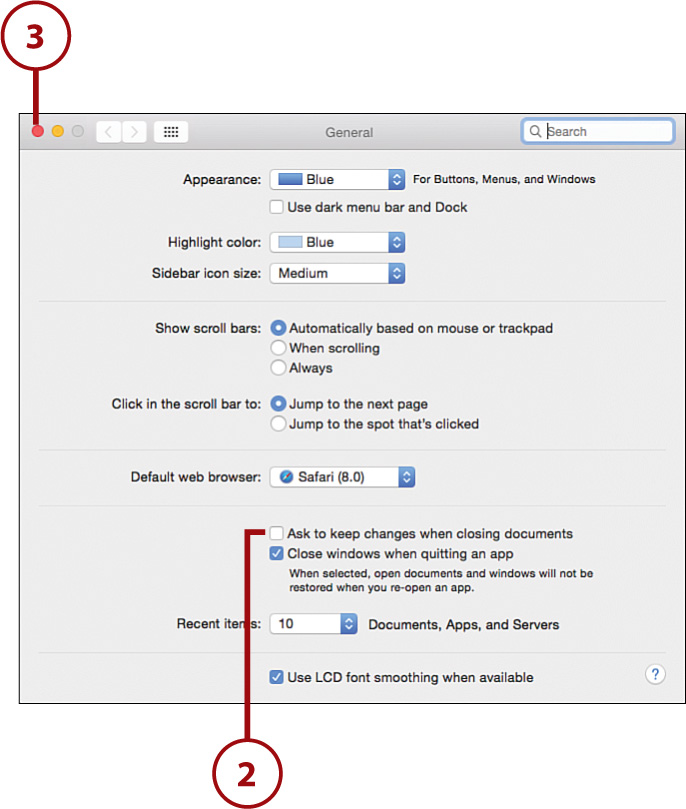2. Making the Most of Your Screen Space
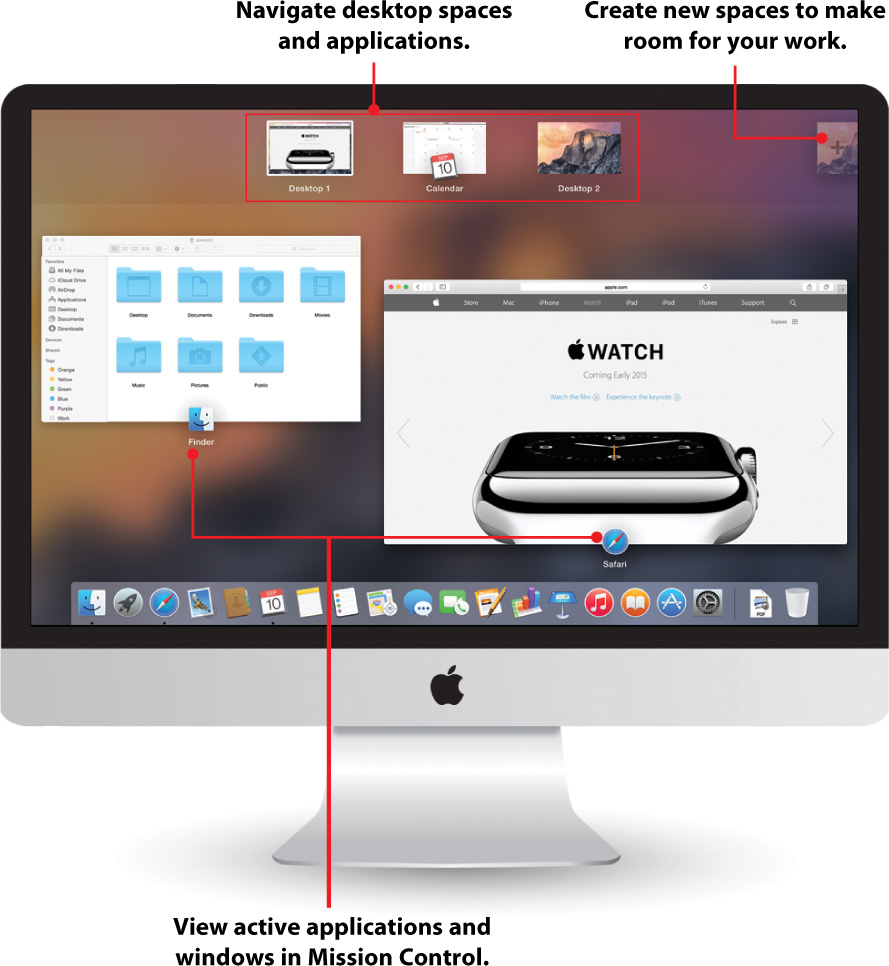
In this chapter, you learn how to take control of your applications and windows, including:
![]() Finding your way around Mission Control
Finding your way around Mission Control
![]() Managing applications and windows
Managing applications and windows
![]() Creating new spaces
Creating new spaces
![]() Launching applications with Launchpad
Launching applications with Launchpad
![]() Creating application groups in Launchpad
Creating application groups in Launchpad
![]() Uninstalling applications through Launchpad
Uninstalling applications through Launchpad
![]() Managing auto open and save features
Managing auto open and save features
As applications become more complex, so does the task of managing them. Software is installed everywhere, windows are spread out over your desktop, and just trying to find your way through the maze of information overload can be nightmarish. Yosemite attempts to bring the madness under control by way of Mission Control.
Mission Control, combined with features such as Spaces, Launchpad, full-screen apps, auto application, and window restoration, makes it easy to navigate the most cluttered computer. The biggest problem? Many of these features are hidden until you invoke them. In this chapter, you learn how to do just that!
Swimming in a Sea of Application Windows with Mission Control
One of the big benefits of modern operating systems is that they enable you to run multiple applications at once. Unfortunately, no matter how much screen space we have, we always need more! To help manage the ever-expanding collection of windows that you need to work within, Apple provides Mission Control as part of OS X Yosemite. Mission Control helps you view your running apps, see the windows they have open, and even expand the amount of desktop real estate you have available.
Opening and Closing Mission Control
To manage Mission Control and access its features, follow these instructions:
1. Slide three fingers up your trackpad, double-tap two fingers on the Magic Mouse, or press the Mission Control key (F3) on your keyboard. Mission Control opens. Spaces appear on the top; the current space is in the center of the screen.
2. Slide three fingers down on the trackpad, double-tap two fingers on the mouse, or press the Mission Control key again. Mission Control closes.
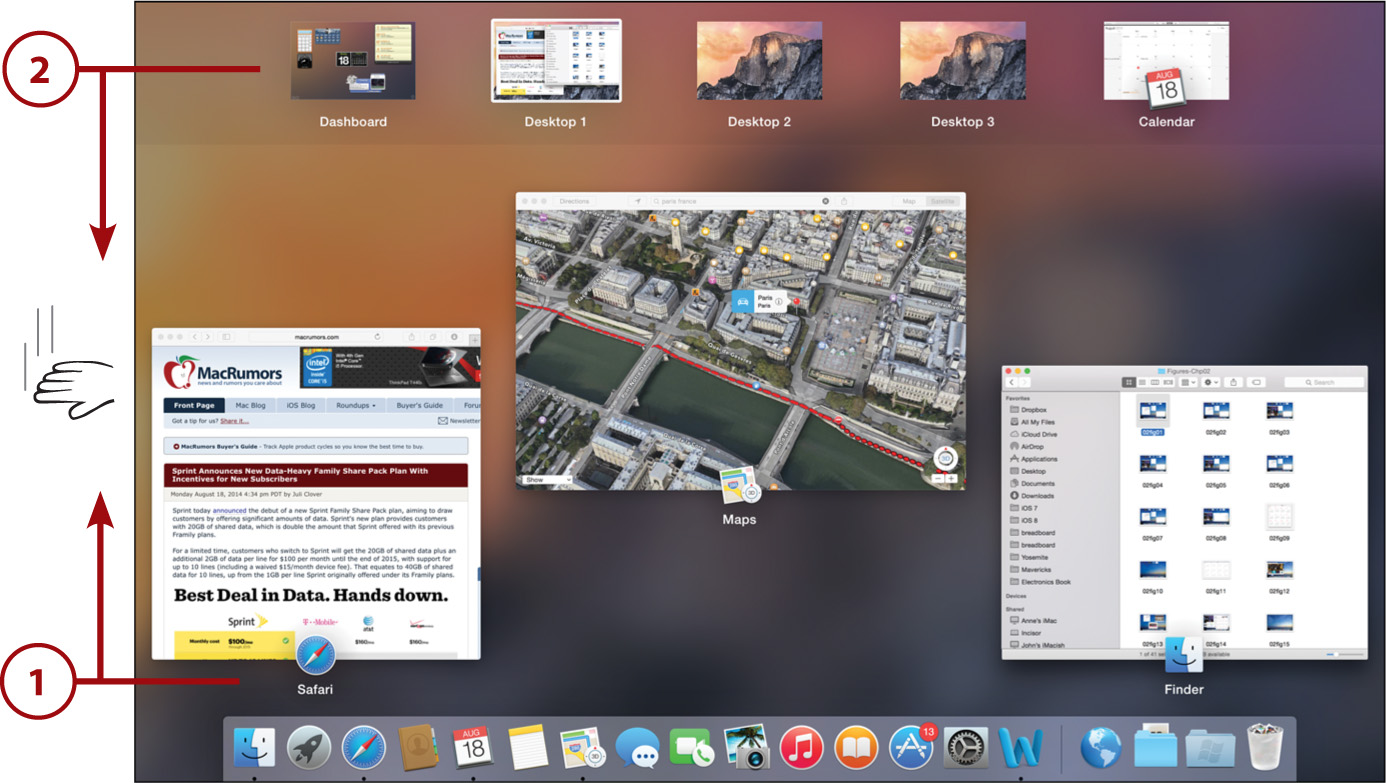
In Mission Control terms, a “space” is a single screenful of information. It can be your Dashboard screen, your typical desktop, a full-screen app, or even additional desktop views that you create.
Docking Mission Control
If you prefer to start Mission Control by clicking, you can use the Mission Control icon. It’s in the Dock on machines without a multitouch trackpad—but you can add it from the Applications folder on any Mac.
Navigating Applications and Windows
When you start Mission Control, your current space (probably your desktop, if you’re starting Mission Control for the first time) is front and center, along with representations of each app running in the space and its windows.
To switch between applications and their windows, do the following:
1. Start Mission Control.
2. Click an application icon to exit Mission Control and bring the application to the front.
3. Click a window to exit Mission Control and bring the chosen window to the front.
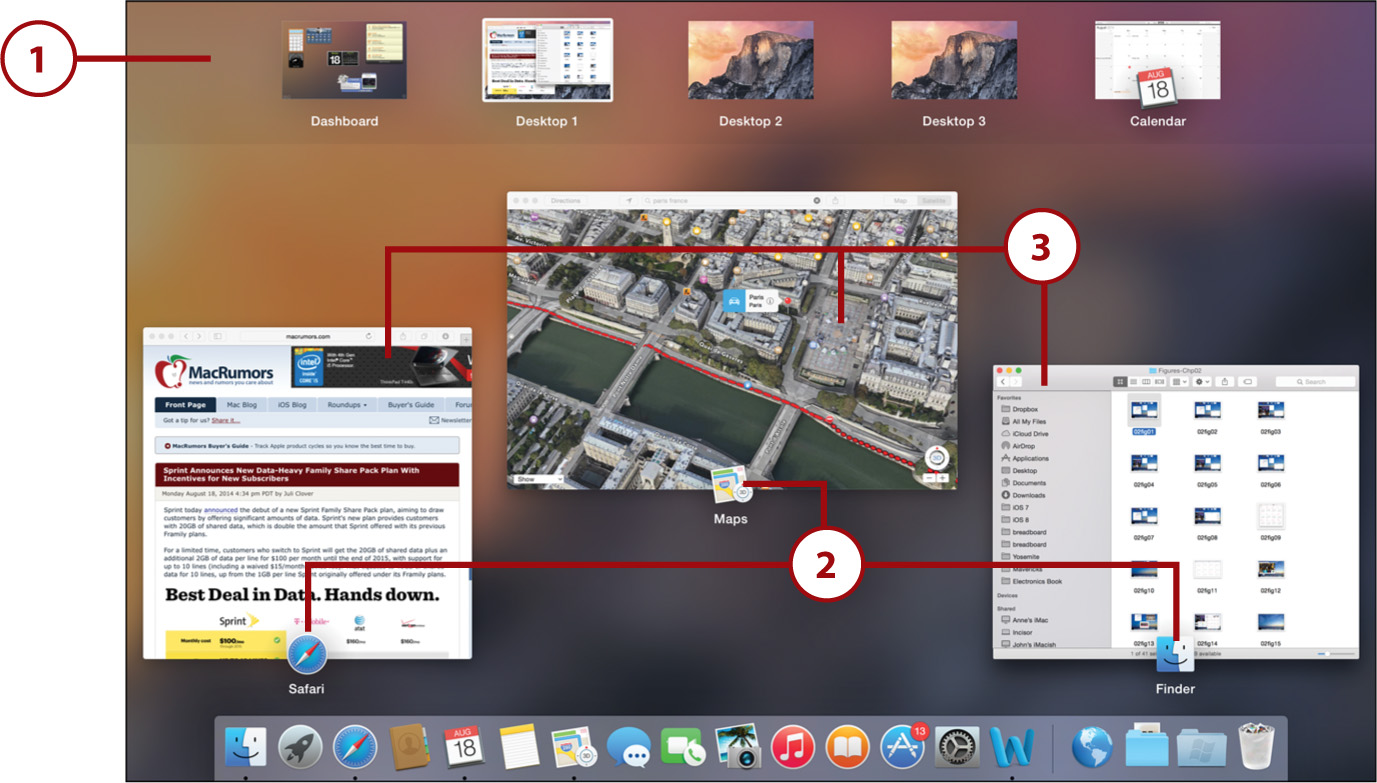
4. To preview the contents of a window, position your pointer over the window and then press the spacebar. Press the spacebar again to hide the preview.
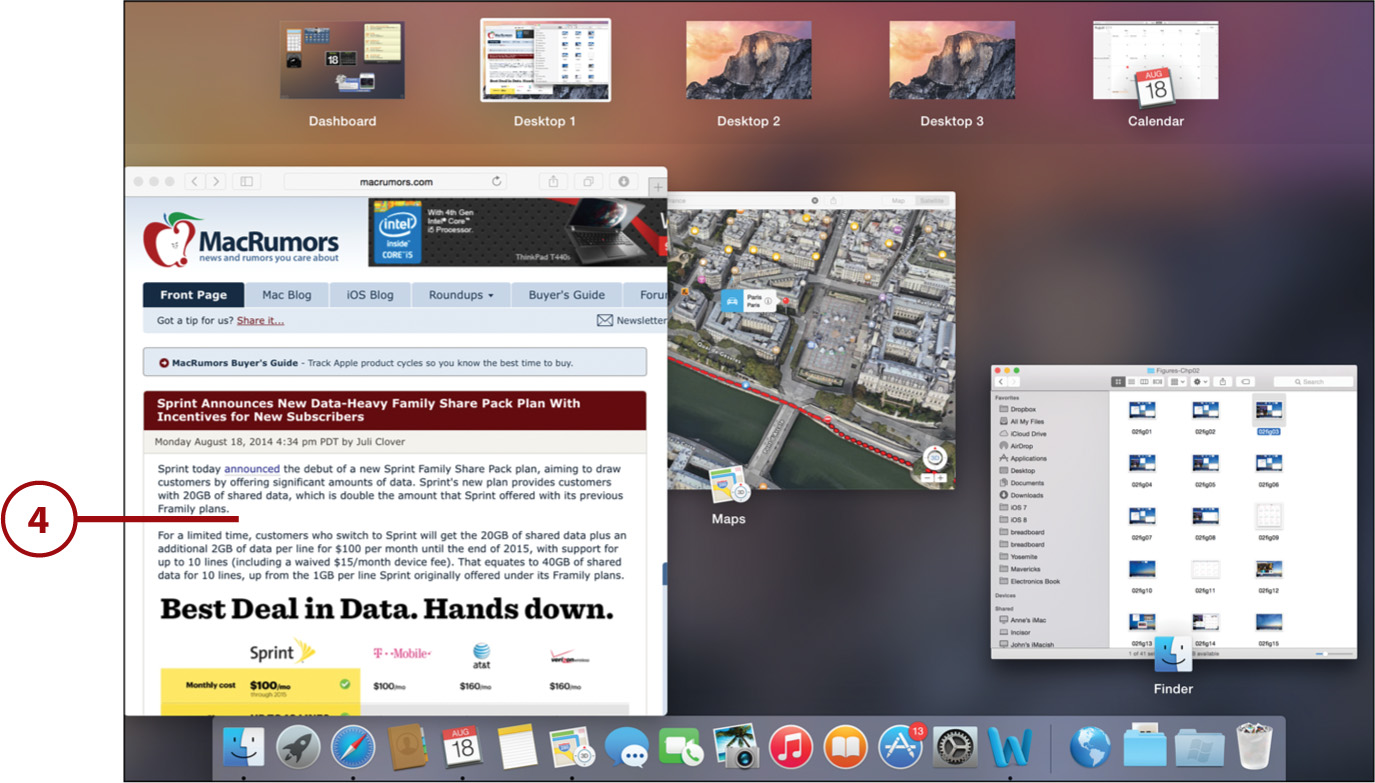
Creating and Populating a New Space
Modern applications look like the cockpit controls of advanced aircraft; it can be overwhelming finding your way around a single application—let alone 10. With Mission Control, however, you can create new desktop spaces dedicated to whatever applications you’d like. To do so, start Mission Control and follow these steps:
1. Move your mouse to the upper-right corner. A + button appears as your mouse approaches the corner; click it.
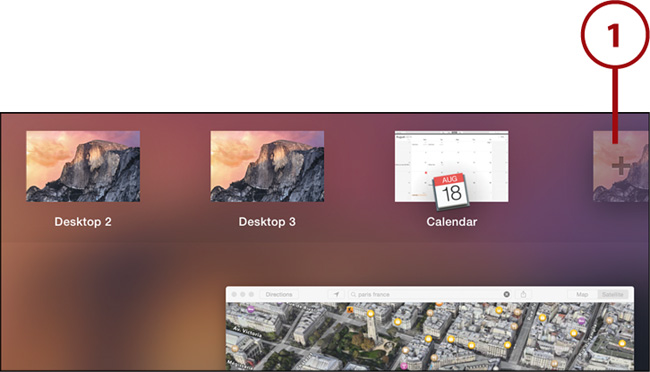
2. A new space is created and a thumbnail of its contents is added to the top of Mission Control.
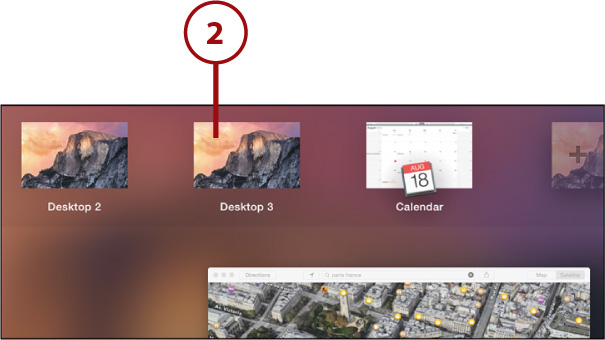
3. Drag application icons or even individual windows from the current space to the thumbnail of the new space.
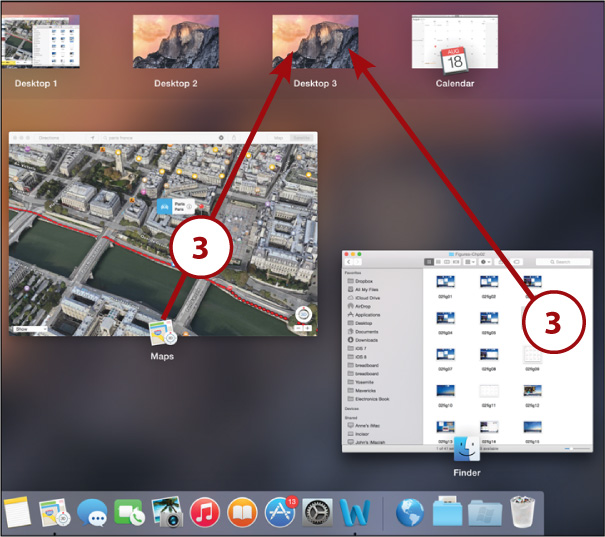
Switching Between Spaces
After you’ve created a new space, you can switch to it via Mission Control or using a trackpad gesture:
1. Start Mission Control.
2. Click the space thumbnail you want to display, or swipe left or right with three fingers to move between spaces.
3. Click on the background to exit Mission Control.
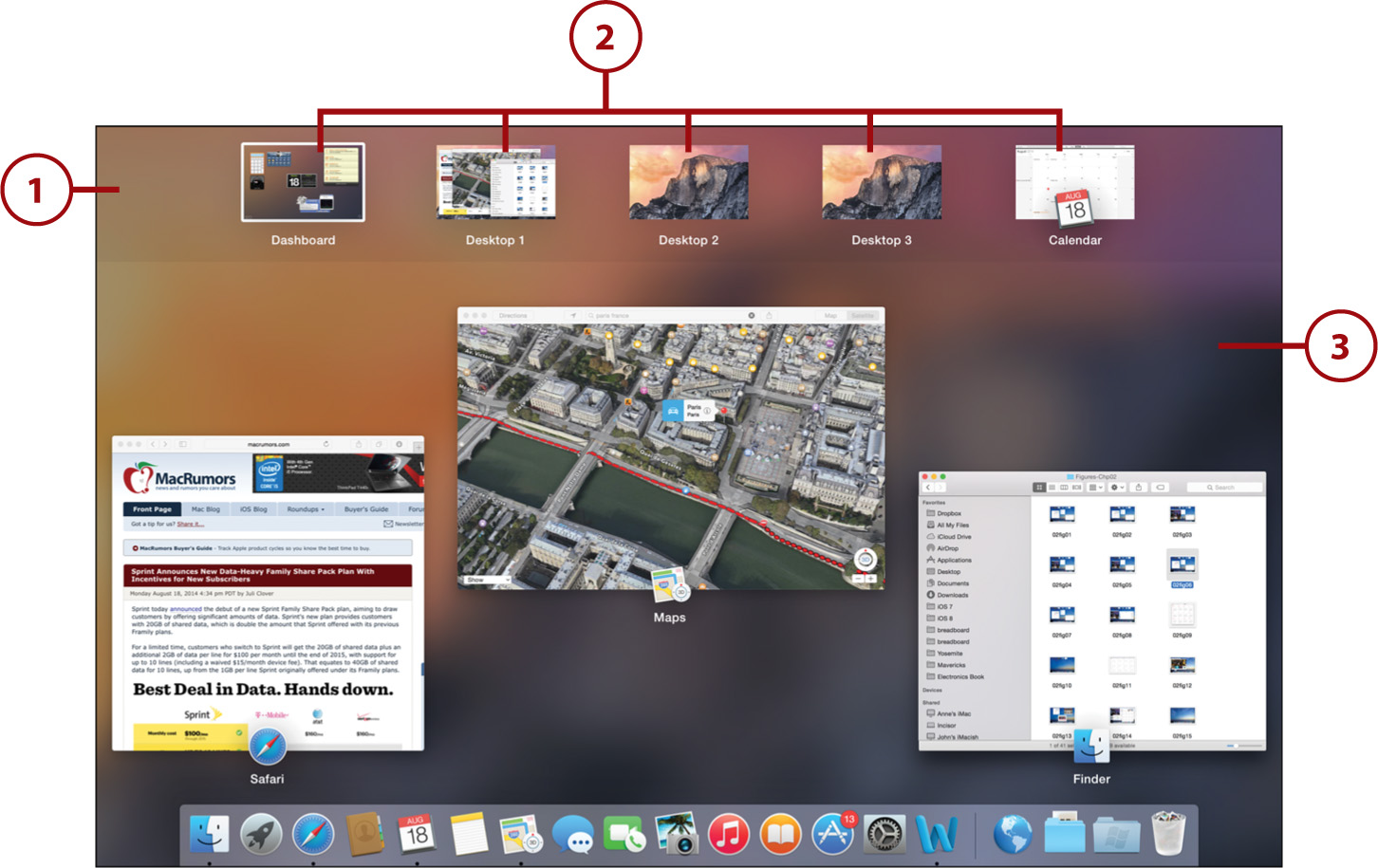
Even Faster Space Switching
The fastest way to switch between Mission Control spaces is without even starting Mission Control. Swipe left or right with three fingers on your trackpad (or two fingers on the Magic Mouse) at any time to move between spaces.
Closing a Space
It’s so easy to create spaces, you might find yourself with some extra ones you need to get rid of. To close out a space, follow these steps:
1. Start Mission Control.
2. Position your cursor over a space.
3. After a few seconds, an X appears in the upper-left corner of the space thumbnail. Click the X to close the space. Any windows within it move back to the primary desktop space.
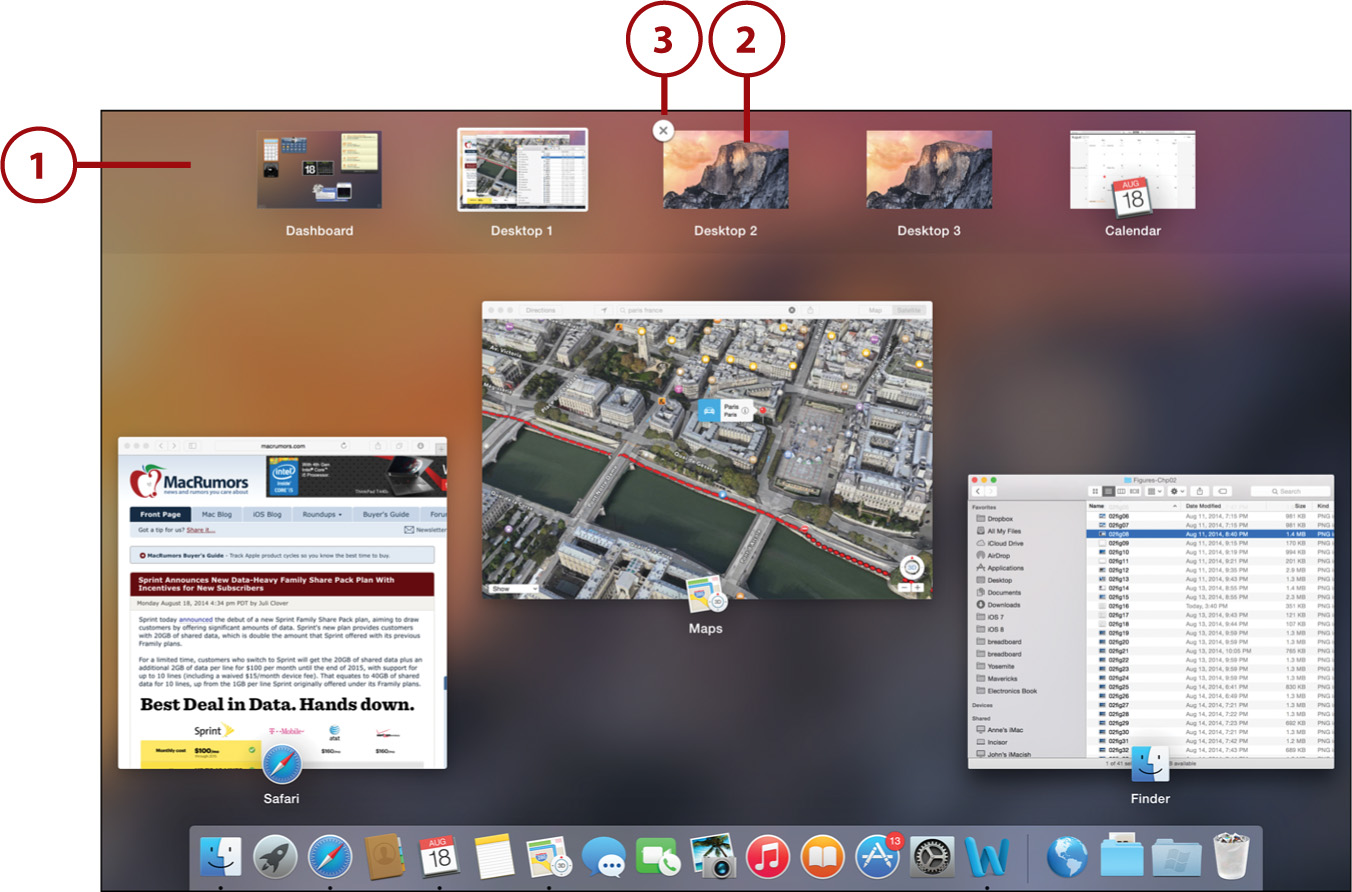
Creating Full-Screen Application Spaces
Spaces are great for providing more, um, space for your windowed applications, but they also serve as a “container” for your full-screen apps. Rather than a full-screen application eating up one of your desktop spaces, it automatically creates a new dedicated space when it starts and removes it when it stops.
1. Click the green double-arrow button in the upper-left corner of an application window to enter full-screen mode.
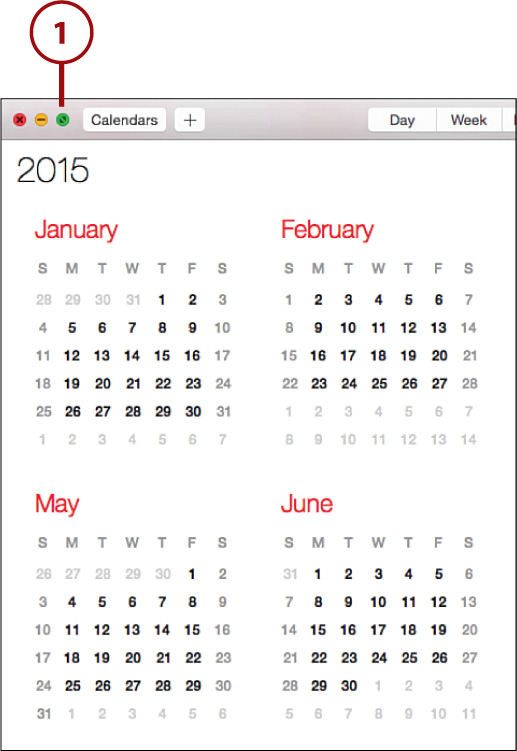
2. A new space is created and is visible in Mission Control.

3. Switch to and from the space exactly as you would any other. When you’re done using the full-screen app, either quit the application or exit full-screen mode by pressing the Escape key or moving your cursor to the top left of the screen and clicking the green button again. The space is automatically removed from Mission Control.
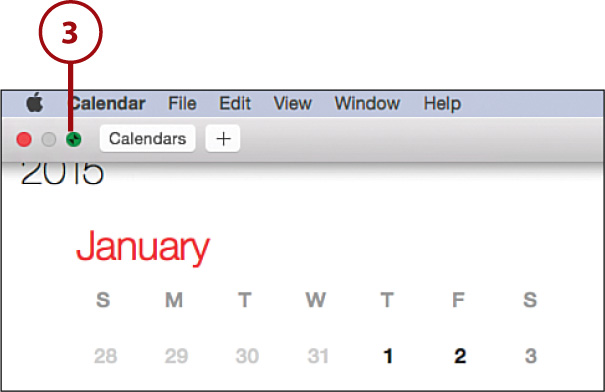
Choosing Between Application Windows
When you just need to navigate your windows, the Mission Control Application windows option comes in handy. Using this, you can show all your application windows, or just the windows for a specific program, with a single click.
1. To display all the windows open within an application, click and hold an active application’s icon in the dock and choose Show All Windows. Alternatively, press Control+down arrow.

2. The screen refreshes to show miniature versions of your windows. Minimized windows appear in the bottom portion of the display; active windows appear at the top.
3. Press the Tab key to switch between active applications, limiting the miniaturized windows to the highlighted application.
4. Click a window to select it and move it to the front.
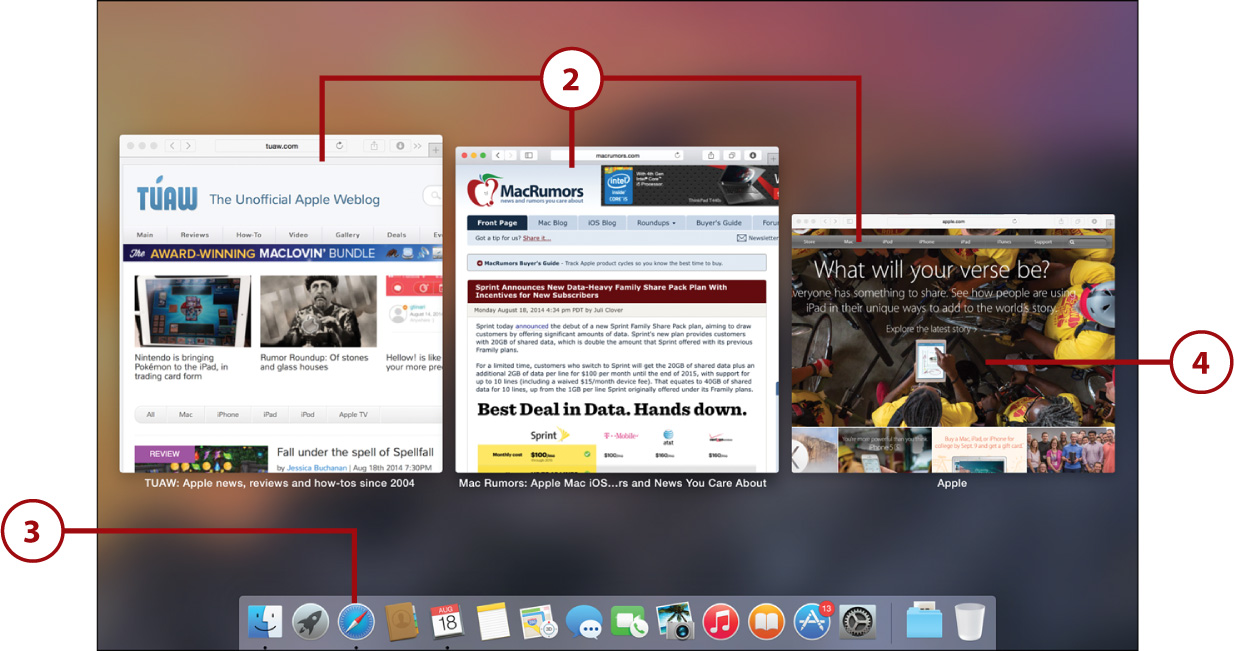
Showing the Desktop
Sometimes you need quick access to the files on your desktop, and rearranging windows (or using the Finder’s Hide menu) isn’t very efficient. Mission Control’s Show Desktop feature comes in handy here:
1. To clear all the windows off the screen so that you can temporarily work with the desktop, press F11 (you need to hold down the function key).
2. You can now work within the desktop with no obstructions. Press F11 again to return the windows to their original positions.
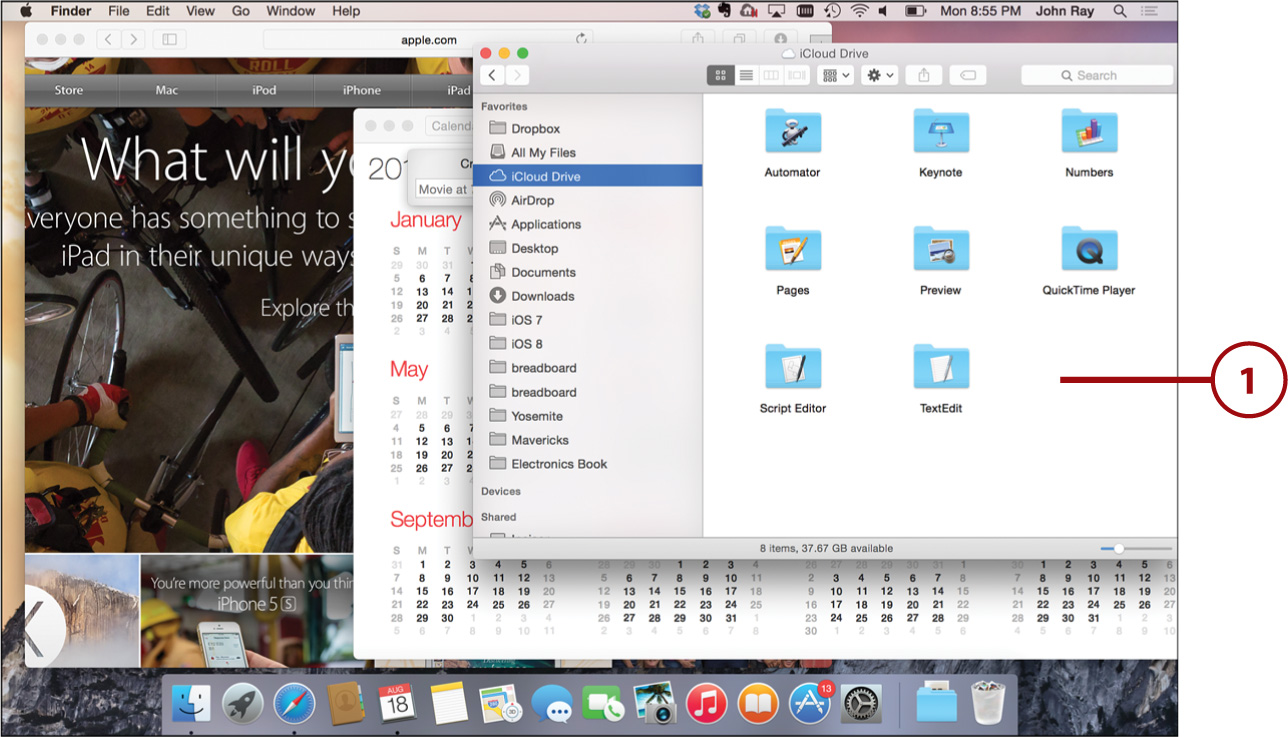

If Only Real Life Were So Easy...
To quickly drop a file from the Finder into another application (such as an attachment into an email message), start dragging a file while the desktop is cleared, press F11 to return the windows to the screen, and then finish dragging and dropping the file into an application.
Configuring Mission Control Features and Shortcuts
If you have a specific way of working and want to customize how Mission Control or any of its features is activated, just follow these steps:
1. Open the System Preferences application, and click the Mission Control panel icon.
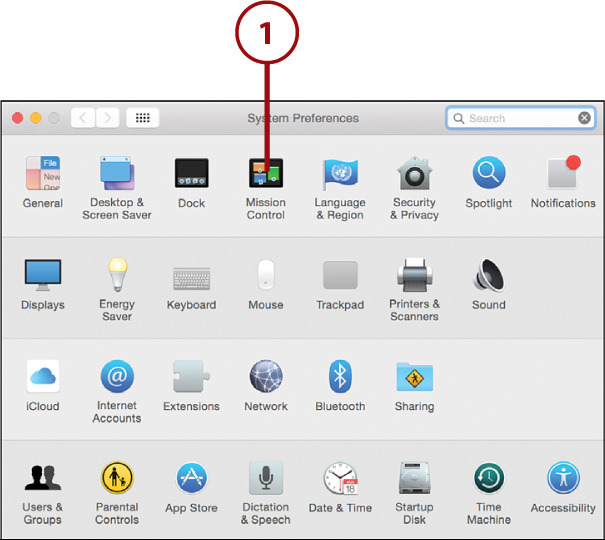
2. Uncheck Automatically Rearrange Spaces Based on Most Recent Use if you prefer that Yosemite keeps your spaces in the same order you add them, regardless of your usage patterns.
3. In most cases, leave When Switching to an Application, Switch to a Space with Open Windows for the Application checkbox checked. This indicates that when you switch to an application (using the Dock or Command+Tab), you automatically switch to the space that contains its open windows.
4. If you prefer application windows to not be grouped under their application icon in the Mission Control display, uncheck Group Windows by Application.

5. If you’re lucky enough to have multiple monitors connected to your Mac, check Displays Have Separate Spaces to have each display act as a separate work area with its own collection of fullscreen apps and workspaces. To use the monitors as a single unified space, uncheck this option.
6. Use the Dashboard pop-up menu to choose whether Dashboard should be its own space, displayed as a transparent overlay, or turned off entirely.
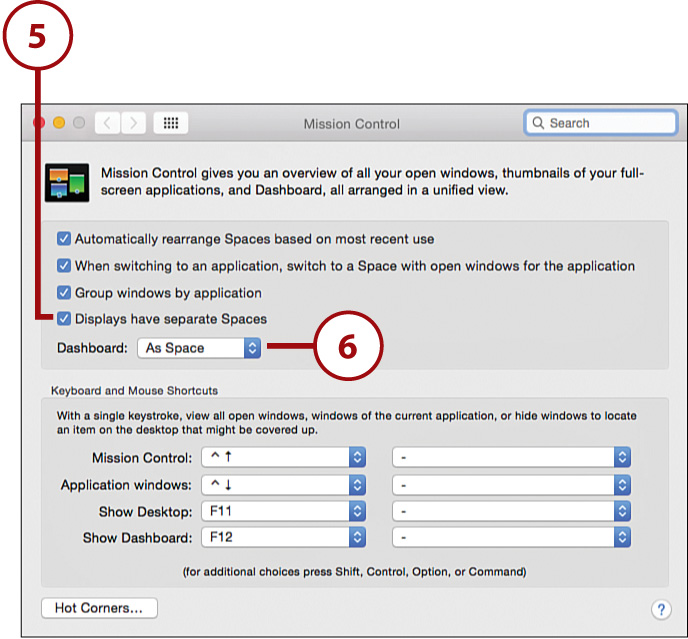
7. At the bottom of the panel, use the pop-up menus to configure keyboard and mouse button combinations to invoke the Mission Control features and Dashboard.
8. To trigger these features by moving the mouse to the screen corners, click the Hot Corners button.

9. Use the pop-up menus beside each screen corner to choose among the different options. After you’ve made a selection, just move the mouse into that corner to invoke the feature.
10. Click OK when finished.
11. Close the System Preferences.
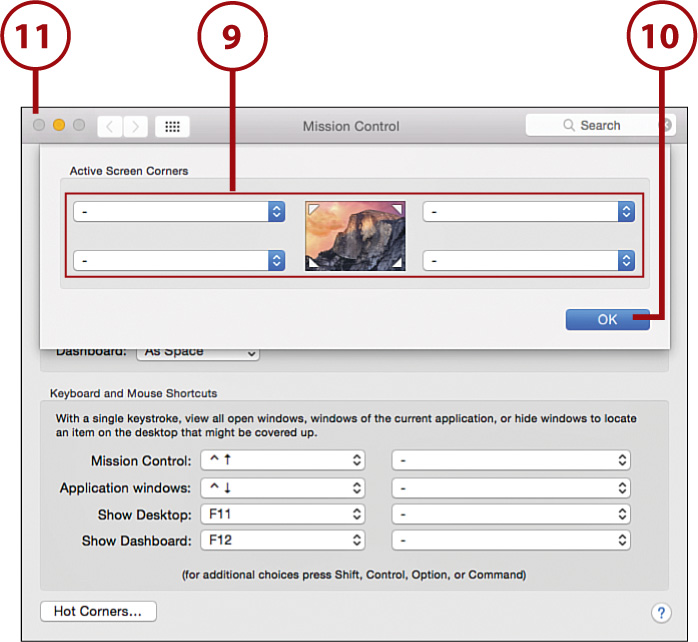
Remember Your Gestures!
As you know, you control Mission Control through gestures, and these aren’t set in stone! Use the trackpad or Mouse System Preferences panels to configure the gestures used by Mission Control.
Managing and Launching Applications with Launchpad
Whereas Mission Control helps you find your way through your windows, the Launchpad eliminates the need to open them. Launchpad brings iOS-like application management to your Mac. Instead of digging through folders to launch an application, you simply start Launchpad and all your installed apps are visible in one place. No digging required.
Starting Launchpad
Like Mission Control, Apple wants to keep Launchpad at the ready. Unlike other applications, it takes no time to start and can be invoked through a gesture:
1. Open Launchpad by performing a pinching gesture with your thumb and three fingers on your trackpad. Alternatively, press the Launchpad key (F4), or click the Launchpad icon in the Dock or in the Applications folder.
2. The Launchpad appears, blurring out your background.
3. Reverse the pinching gesture, or click on the background to exit Launchpad.

Navigating Launchpad
If you’ve used an iPad or an iPhone, you immediately know how to navigate Launchpad. If you haven’t, don’t worry—it takes about a minute to learn everything you’ll need to know.
1. Open Launchpad to access your applications.
2. Click an application icon to launch it.
3. Click a folder icon to open it.
4. Click outside the folder to close it.
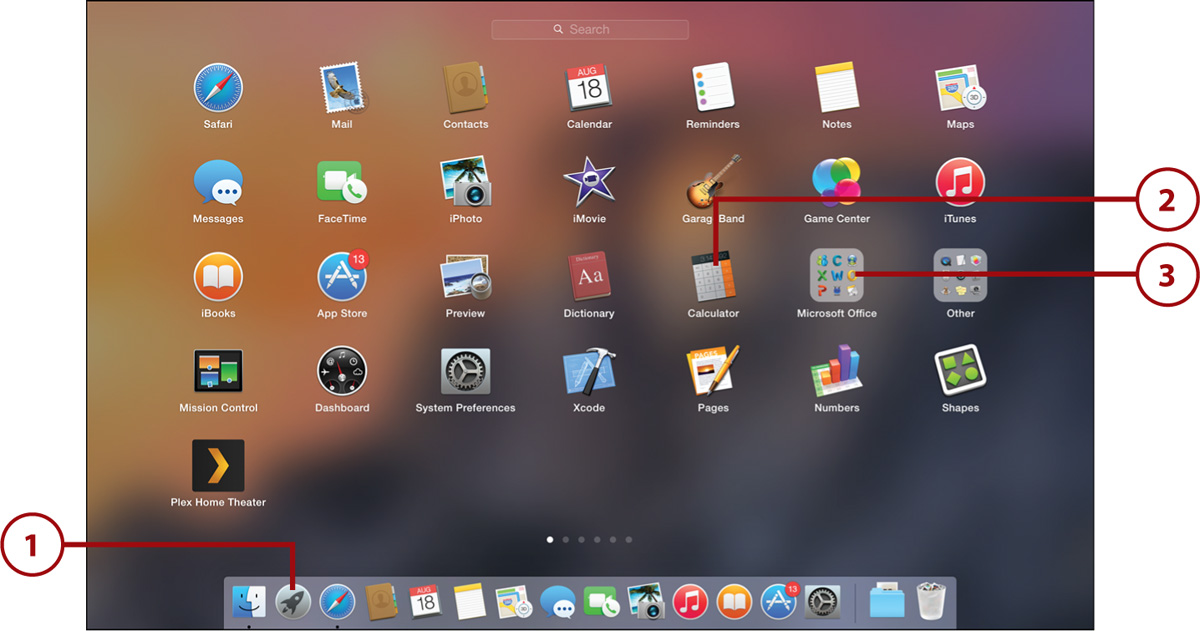
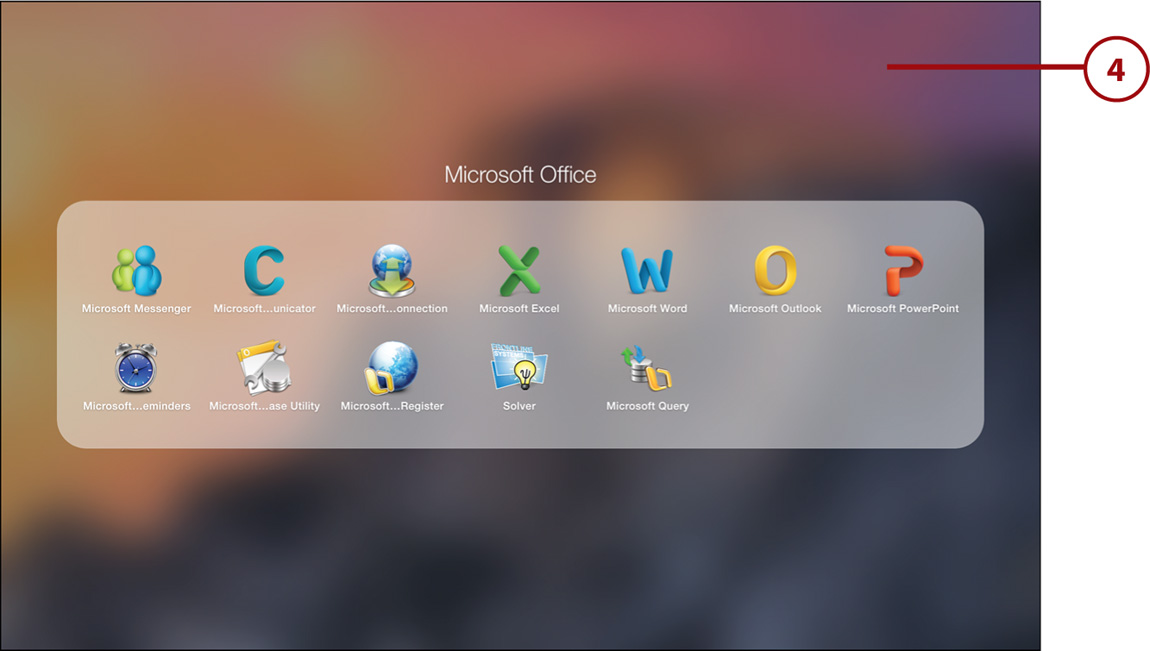
5. There can be multiple pages of icons, represented by the dots at the center bottom of the screen.
6. Move between pages by swiping left or right with your fingers, clicking the dots, or clicking and dragging left or right.

Searching Launchpad
If you can’t find an application you’re looking for, you can easily search for it directly in Launchpad.
1. Open Launchpad.

2. Click to type in the search field.
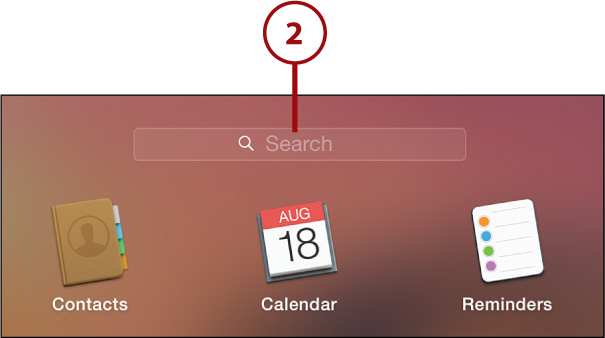
3. Enter a few characters of the name of the application you’re looking for.
4. Launchpad refreshes to show the search results. The best match is highlighted.
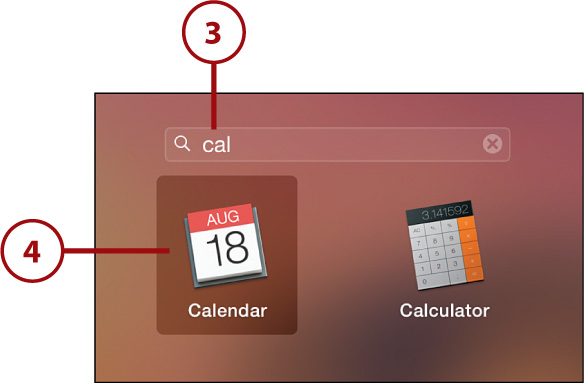
Rearranging Icons
The Launchpad display is completely customizable. To rearrange the icons on your screen, follow these instructions:
1. Open Launchpad.
2. Click and drag the icon to a new location—even a new page. Release the mouse to place the icon.
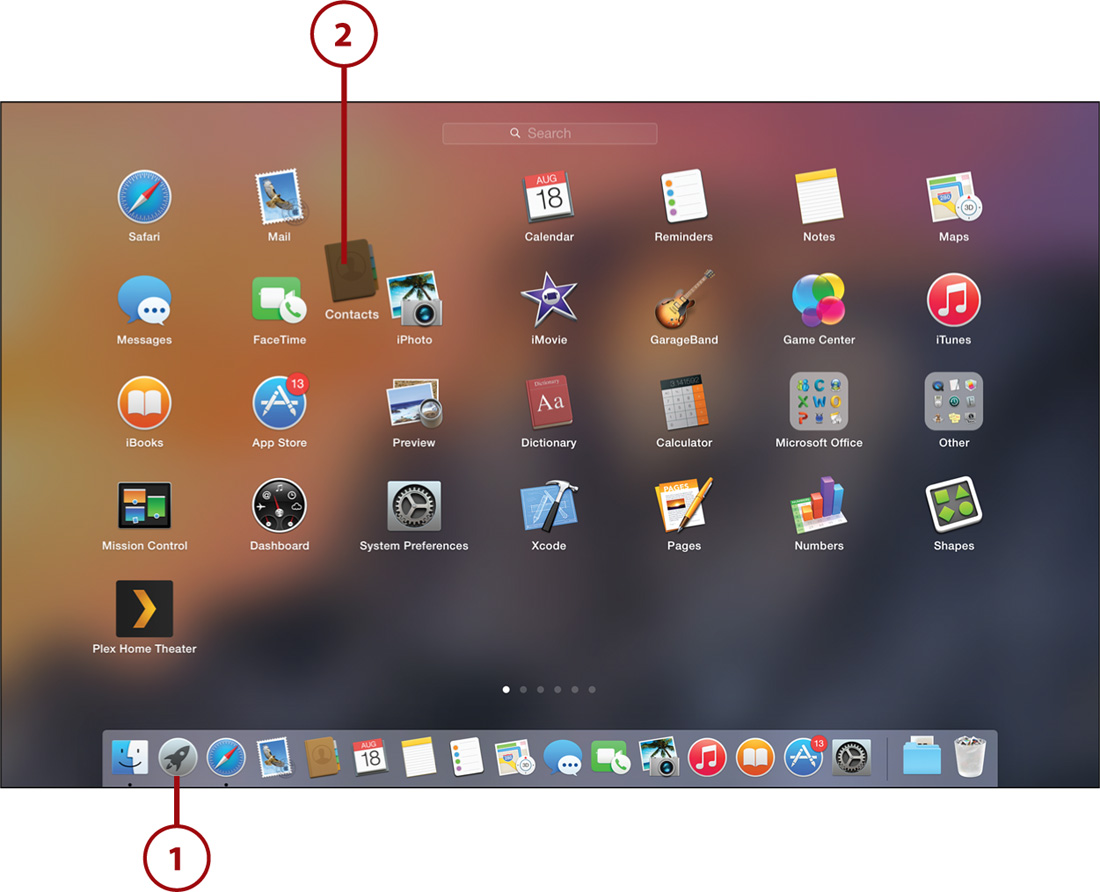
Creating New Folders
Unlike folders in the Finder, Launchpad folders are created on the fly and automatically disappear when all their contents are removed. To create a folder in Launchpad, follow these steps:
1. Open Launchpad.

2. Drag an icon on top of another icon that you want to group it with.
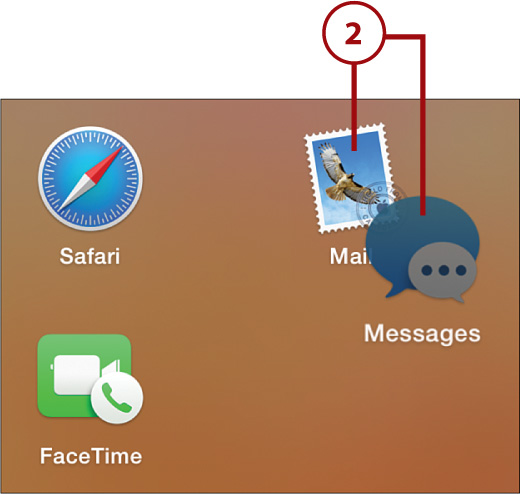
3. A new folder is created and opened, and the icons are added.
4. Click the title of the folder to rename it.
5. Click on the background outside the folder to close it.
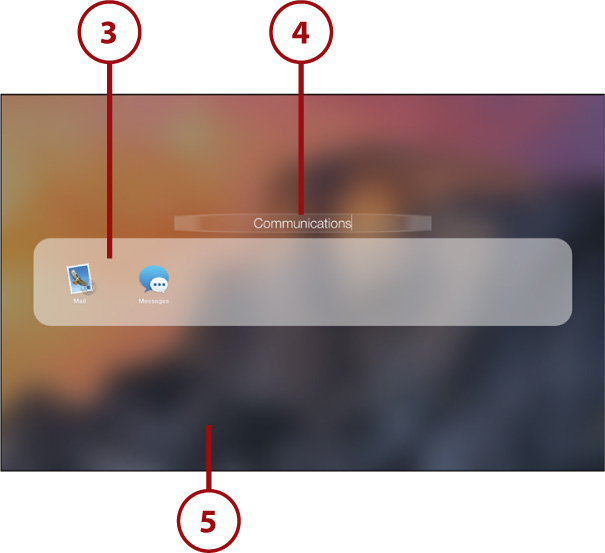
The Folder That Wasn’t There
Folders you create or delete in Launchpad do not alter your file system. They are purely logical groupings and do not affect the location of your actual files.
1. Open Launchpad.

2. Click the folder that you want to remove.
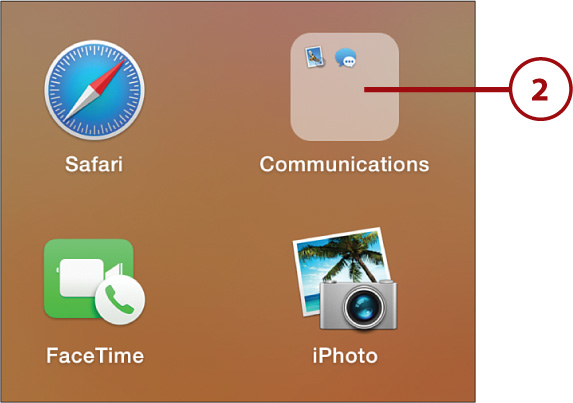
3. The folder opens.
4. Drag each item out of the folder.
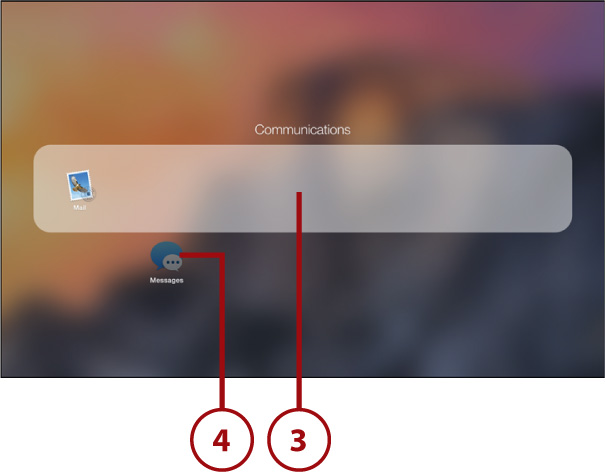
5. When you reach the last item, the folder vanishes automatically.
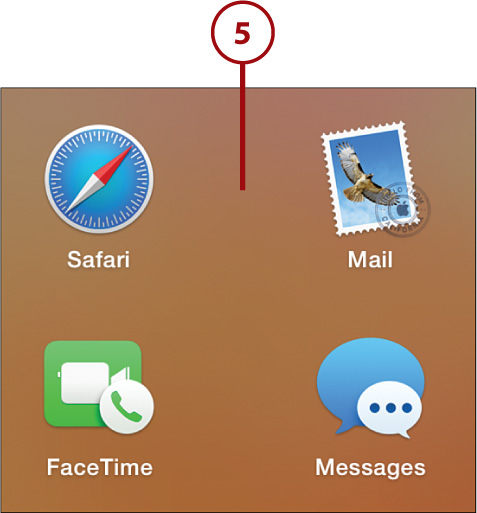
Deleting Applications
In addition to providing a quick way to access your applications, Launchpad offers an easy way to uninstall applications that you’ve installed from the Mac App Store. (See Chapter 10, “Installing and Managing Applications and Extensions on Your Mac,” for details.)
1. Open Launchpad.
2. Drag an application you want to uninstall to the trash. Alternatively, click and hold on the icon until an X appears in the upper left, and click the X.
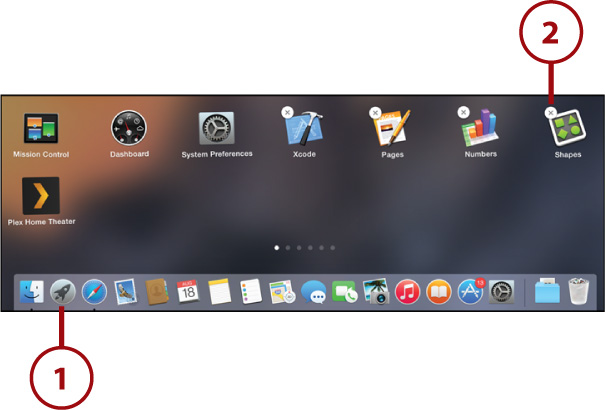
3. You are prompted to confirm the deletion.
4. Click Delete. The application is uninstalled from your system. You can reinstall it through the App Store if needed.
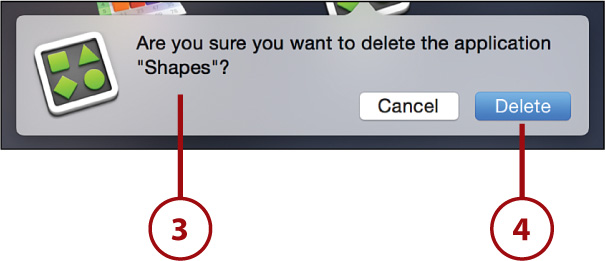
Managing Auto Open and Save Features
Yosemite offers some unique features that save you time when you’re booting your system after some downtime, starting an application you use frequently, or even just saving files. Although these can be useful, they can also be disconcerting to users who expect more conventional behavior—such as explicitly choosing when to open applications and save files.
Toggling Application Auto Open
By default, applications and windows open at login exactly as you had them when you shut down your computer. This is a nifty feature, but it also means you might have software starting at boot that you didn’t intend. You can toggle this feature on and off by following these steps:
1. Choose Log Out from the Apple menu.
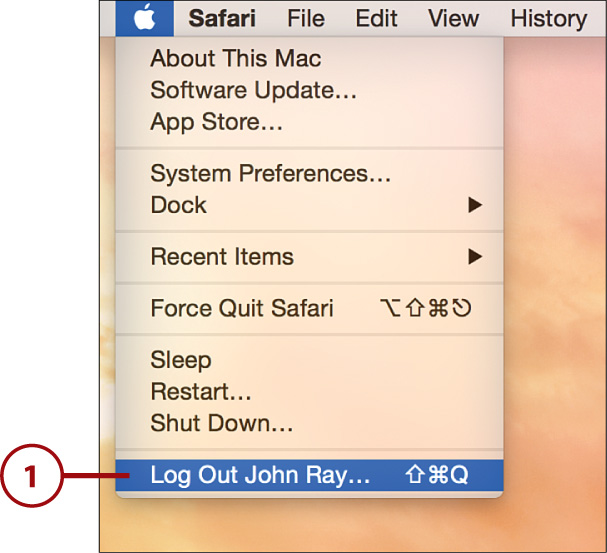
2. Uncheck Reopen Windows When Logging Back In to disable automatic application startup, or check the box to re-enable it.
3. Click Log Out or Cancel. Your preference will be maintained regardless of your choice.

Setting Window Restoration
In addition to restoring applications, Yosemite can restore the open files and windows that you were using when you quit an application. By default, this feature is turned off, but you can easily toggle it on.
1. Open the System Preferences application and click the General icon.
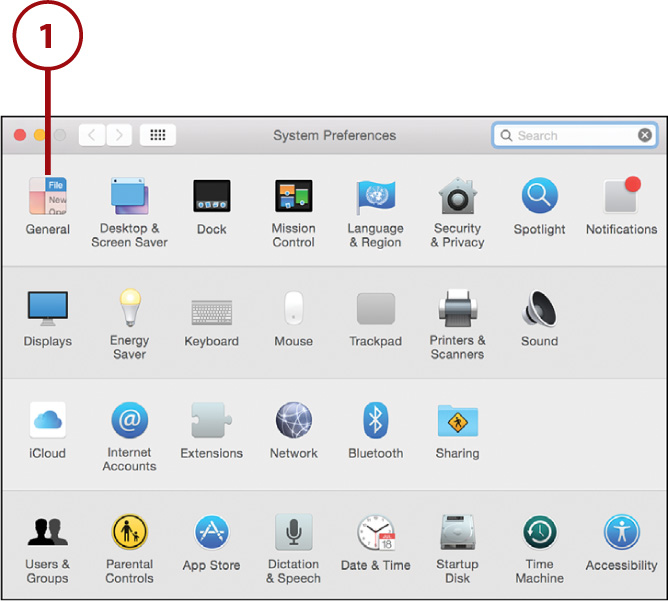
2. Uncheck Close Windows When Quitting an App. This causes your applications to save their current state when they quit. Check the box to disable the behavior.
3. Close the System Preferences.

Temporarily Enable or Disable Window Saving
If you’re not sure you want to use the window restoration feature, or you don’t want to use it with specific applications, you can temporarily toggle it on and off. To do this, just hold down the Option key when quitting your application. The Quit menu selection changes to Quit and Keep Windows or Quit and Close All Windows, depending on your setting in the General preference panel.
Enabling Manual File Saving
When you start working in Yosemite, you’ll notice something “missing” when you work with files: Frequently, you aren’t asked to save them when you close them. Yosemite automatically saves your files, even if you prefer that it didn’t. To change this, complete these steps:
1. Open the System Preferences application and click the General icon.
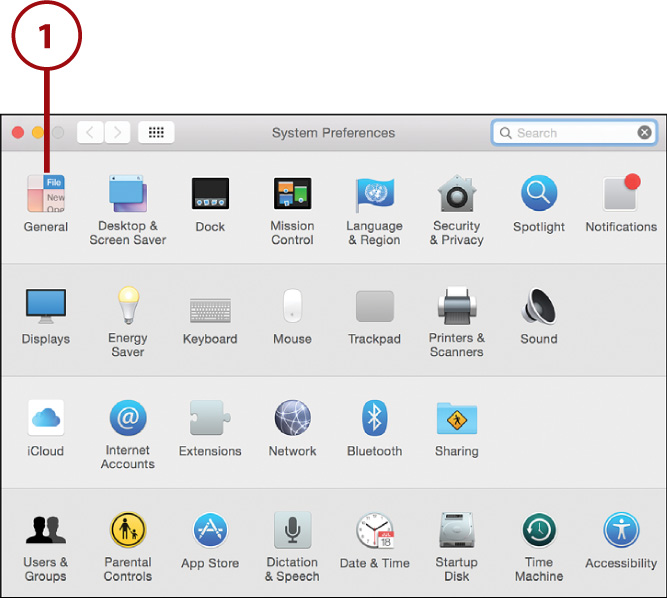
2. Check Ask to Keep Changes When Closing Documents.
3. Close the System Preferences.
